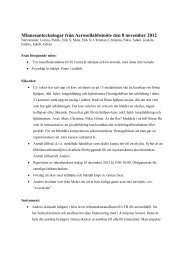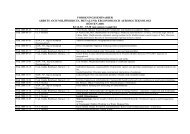ESTIMATING CLOUD DROPLET EFFECTIVE RADIUS ... - CAST
ESTIMATING CLOUD DROPLET EFFECTIVE RADIUS ... - CAST
ESTIMATING CLOUD DROPLET EFFECTIVE RADIUS ... - CAST
- No tags were found...
Create successful ePaper yourself
Turn your PDF publications into a flip-book with our unique Google optimized e-Paper software.
<strong>ESTIMATING</strong> <strong>CLOUD</strong> <strong>DROPLET</strong> <strong>EFFECTIVE</strong> <strong>RADIUS</strong> FROM SATELLITE REFLECTANCE DATAModified Exponential Approximation___________________________________________________________________________________________________ABSTRACTA major uncertainty in modelling future climate is the impact of aerosols on cloud formation,and its influence on the earth’s radiation fluxes. In order to study this indirect effect ofaerosols and its role in global warming, it is important to be able to model the growth of clouddrops.In this study, cloud droplet effective radius is modelled from satellite reflectancemeasurements in two MODIS wavebands, 0.65 µm (visible) and 2.1 µm (NIR). The effectiveradius r e is preferred to mean or mode radius since it accounts for the size distribution of thedroplets within the cloud. Reflectance data is taken from a satellite scene covering southernSweden, on May 9 th , 2004. The approach is a relatively simple approximate forward modelcalled the Modified Exponential Approximation (MEA), developed by Kokhanovsky et al.(2003). This model is valid for optically thick water clouds, and is here applied to cloud pixelswith NIR reflectance R 2 > 0.2 and optical thickness τ > 10. The underlying principle of themodel is the asymptotic theory. This theory is based on the fact that reflectance in thenonabsorbing wavelengths (visible) is mainly a function of τ, while reflectance in theabsorbing wavelengths (near and mid infrared) is governed by r e . For large optical thickness,the reflection function is close to the known asymptotic equations. Also, when the opticalthickness is large enough, τ and r e can be determined nearly independently of each other.The results showed good agreement with near coastline clouds in the study by Rosenfeld andLensky (1998) for R 2 > 0.3. Median and mode effective radius was 14.6 and 15 µmrespectively. A mode r e of 15 µm indicates precipitating clouds or clouds close toprecipitation, since 14-15 µm is considered to be a rainout threshold. Smaller reflectancevalues in the near infrared resulted in larger mode and median r e (18 and 17-20 µmrespectively), and τ < 5. This implies that the model is not reliable for small reflectance valuesin the near infrared. The error for pixels with τ > 10 is estimated to 10-20%, but varies withviewing geometry, optical thickness and probably also wavebands used.i




